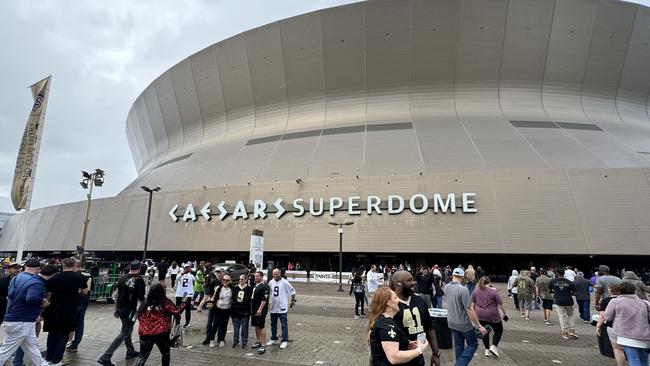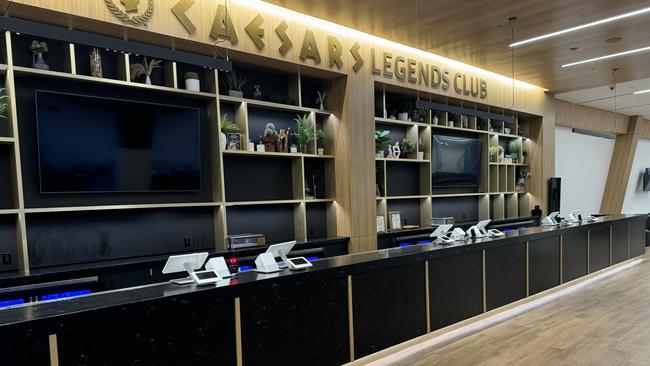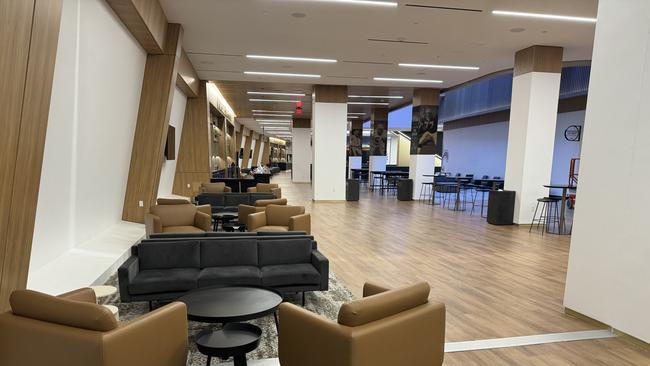New Orleans’ $828m Superdome Super Bowl investment exposes Brisbane Olympic farce
The bumbling organisation of the Brisbane 2032 Olympics so far has shown Australia has plenty to learn about hosting a worldwide event.

NFL
Don't miss out on the headlines from NFL. Followed categories will be added to My News.
If reports about the 2032 Brisbane Olympics are anything to go by, Australia still has a lot to learn about getting ready to host a major event.
After the City of Love sparkled at the 2024 Paris Olympics, already it appears as though the 2028 Games in LA are going to be a spectacle to behold.
But despite being the only real bidder for the 2032 Games, Brisbane’s plans have been hit by infighting and belt tightening as if it was a surprise hosting the Olympics would require substantial investment.
Suggestions of hosting the showpiece athletics events at the modest Queensland Sports and Athletics Centre (QSAC), even with a $1.6 billion upgrade to allow the venue to host 40,000, was determined to be “going backwards” by former premier Annastacia Palaszczuk.
But while new Queensland premier David Crisafulli scrapped the idea with his full plan to be decided in the first 100 days of his term, the plans are up in the air as questions arise about the state’s ability to satisfactorily host the world’s biggest sporting extravaganza.
Generally, the athletics are held in the Olympic Stadium and the world still doesn’t know if Brisbane will hold it in the iconic Gabba or a new stadium.
Crisafulli is reportedly deciding on whether the state pursues a $2.7 billion upgrade to the Gabba or a new stadium worth around $3.4 billion with a proposed 60,000 to 80,000 capacity.



The Gabba is set to be at the end of life by the early 2030s with $500m required just for maintenance just to get it through to 2030.
It’s also reportedly not compliant with modern building codes or disability requirements and would take $1 billion to get it up to code.
All this goes to show that Brisbane bid for the event didn’t have a solid plan of action to execute the event – and while there is still eight years until Australia opens its doors, these are major works and Olympics generally go right down to the wire in preparing their venues.
But there could be another way.
New Orleans is set to host the 2025 Super Bowl LIX, a record-equalling undertaking that will see the city draw level with Miami on 11 for most times hosting one of the biggest annual sporting events in the world.
The city’s iconic Superdome will host its eighth Super Bowl – the other three were held at Tulane University before the 83,000-capacity stadium was built in 1975, months after the city hosted Super Bowl IX.

Even though the Super Bowl is an annual event, New Orleans has spent the best part of six years getting ready.
Originally set to host last years’ Super Bowl, it was pushed to 2025 due to a conflict with the city’s famous Mardi Gras.
And the Super Bowl won’t even be the biggest event of the month in February with Mardi Gras bringing a reported 1.5m people to New Orleans annually for the event with an economic impact of nearly $1 billion for the city.

The Superdome itself has had a $US535 million ($A828 million) makeover to update the nearly 50-year-old venue in time for the Super Bowl after being awarded the big game in 2018.
Voice of the city’s NFL franchise the New Orleans Saints for WWL Radio Mike Hoss said the renovation had been all about making space and connection for the fans, bumping out walls and replacing space intensive ramps out and replacing them with stairs – saving approximately 100,000 sq ft of space or over two acres.
It has allowed space to open two 40-foot (36m) bars, one on either side of the field, along with countless options for food and beverages for fans.
There’s also a new Legends Club, with extra seating and concessions. But there has been one problem with the extra room so far.
“There’s so much space people are scared to use it,” Hoss told news.com.au during a recent visit to the site.
And those renovations are just some of the improvements that makes the Superdome such an awe-inspiring building.
But renovating the Superdome has also allowed the city to maintain some of its history.
“I go to Sofi, I go to all the new ones they spent $5 billion on, they have no soul, no character,” Hoss said.
“That’s the difference of Caesar Superdome, that’s the difference with New Orleans.”



Having opened in 1975, the Superdome is the fifth oldest stadium currently used in the NFL, with only Chicago’s Soldier Field (1924), Green Bay’s Lambeau Field (1957), Kansas City’s Arrowhead Stadium (1972) and the Buffalo Bills’ Highmark Stadium (1973) currently older.
While most NFL stadiums usually have a 30-year lifespan – only six are currently more than three decades old – the Superdome has its own history, having been a “refuge of last resort” during the dark days of Hurricane Katrina in 2005.
Hurricane Katrina was the fourth deadliest hurricane in US history with 1392 fatalities, and an estimated clean up bill of $US125 billion – still tied for the most expensive in the nation’s history. For comparison, the two hurricanes – Helene and Milton – which hit Florida earlier this year could cost around $60 nillion.
After the stadium was left in a state of disrepair that led many to believe the Superdome would have to be demolished, the city instead decided to repair the stadium, which is in keeping with the aesthetic of New Orleans.

Doug Thornton, executive vice president of ASM Global, the company which manages the Superdome as well as stadiums around the world including Qudos Arena and Suncorp Stadium in Australia, said the planning from back in the late 1960s has allowed the stadium to evolve over the past 50 years.
“In 2024, we are approaching the end of our second 30-year life span,” Thornton said.
“Katrina hit when the building was 30 years old and we were talking about whether we should renovate or whether we should build a new stadium at that time. We were studying that.
“And then we say god did for us what we couldn’t do for ourselves and that was get serious about the renovation. We had no choice – we had to repair and renovate the stadium if we were going to have the Saints come back and have this building stimulate the economy.”
For context, despite the team having been founded in New Orleans in 1967, after Hurricane Katrina struck, there was a push from San Antonio, where the Saints had made a temporary headquarters at the Alamodome during the disaster, to permanently relocate the team to the city.
Thornton continued: “So we made the decision to renovate. We were able to get it open within one year – the Federal government paid for a lot of that restoration – not improvements.”

The Superdome underwent upgrades in the early 2010s, before hosting the 2013 Super Bowl and has been receiving upgrades since in order to attract events like Final Four college basketball tournaments, WWE’s WrestleMania events, major college football matches and even concerts, such as Taylor Swift, who had a three-night run in late October.
“What the Taylor Swift event really showed and highlighted was that if you really want an event that brings people together in one place, at one time where you feel connected with every single person you’re celebrating with, there really just isn’t a better place to do it,” president and CEO of New Orleans & Company Walt Leger III said.
“Because of the way things are laid out here, but also just because of the way the community embraces it.”
And despite having the city’s 11th Super Bowl coming up quickly ahead, chairman of the Super Bowl host committee Marcus Brown said New Orleans isn’t even close to the finish line.
“We’re hosting our 11th Super Bowl, our goal is to break the tie with Miami and host No. 12 as well,” Brown said.
Similarly, investment has been pumped into the local area with a two-mile long triangle in the centre of New Orleans between the Superdome, the Ernest N. Morial Convention Center – the sixth largest convention centre in America which will host many fan and media activations during Super Bowl week – and the world-famous French Quarter.
The convention centre itself has just undergone a renovation coming in at over $US500 million as the 1.1m square foot (102,000 sqm) premises continues to evolve. And it’s set to rise to over a billion dollars in the near future with plans for a new hotel.
CEO of Ernest N. Morial Convention Center Michael J. Sawaya said it was a sign that New Orleans was “all about hospitality, about hosting people, about being the best tourist destination in the country and one of the best in the world”.
“It will be our 11th Super Bowl – not many cities have that honour,” Mr Sawaya said. “We couldn’t be more excited and more ready, I can assure you that.
“Everyone in this community is doing whatever they can to make this the best Super Bowl ever. We’ve spent the last several years dressing up, with plans for this building and improving this building.”

The $US435 million ($A665m) rebrand of Harrah’s New Orleans Casino to Caesars New Orleans including a new 340-room hotel tower which connects to the original hotel and casino, means the hotel boasts nearly 800 hotel rooms in the complex.
And that’s just the tip of the iceberg with the downtown area having 26,000 hotel rooms.
New Orleans Saints and Pelicans owner Gayle Benson said she had “no doubt that this Super Bowl will be one of the greatest sporting events in our city’s history”.
“From experience, we know how to unite, whether in times of challenge or celebration,” Mrs Benson said. “And there is no better place to live, work or visit than New Orleans.”
Whether the same can be said about the Brisbane Olympics remains to be seen, but there are definitely road maps the organisers can follow to ensure not only a successful event in 2032, but a lasting sporting legacy that will long outlive the Games.
After seeing the Superdome and New Orleans already so prepared for one of the world’s major sporting events and ready with a smile, maybe Brisbane has to ask itself exactly what the stadium debate is saying about the state and by extension, Australia.
This writer travelled to New Orleans as a guest of New Orleans & Company
Originally published as New Orleans’ $828m Superdome Super Bowl investment exposes Brisbane Olympic farce





